U.S. Senior Open: Why it's so hard for amateurs to compete
6/27/2022 | by Pete Wlodkowski of AmateurGolf.com
see also: View results for U.S. Senior Open, Scioto Country Club

For just the third time in 42 years, none of the 20 amateurs made the cut - we spoke to four of them to gain some perspective
Before going any further, let's give credit to all of the 20 amateurs that played this year against the legends of the game - many of them, like champion Padraig Harrington, well capable of competing at the PGA Tour level.
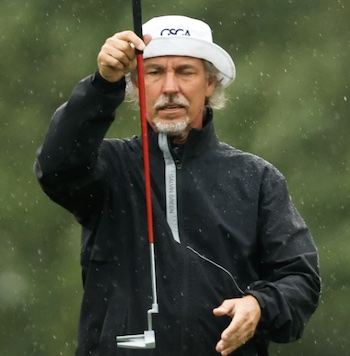
Billy Mitchell on a rainy Thursday (USGA)
But nothing compared to some of the banner years for amateurs like 2008 where six amateurs earned a chance to play on the weekend.
Then in 2009, Tim Jackson of Tennessee shot 66-67 to take the 36-hole lead, before falling back to a tie for 11th. At the time, he tied the 36-hole scoring record at the Senior Open, and set the amateur scoring record for 18, 36, and 72 holes. Jackson's 6-under total was 14 shots behind winner Fred Funk, who posted 20-under-par.
Here are a few reasons it's only getting tougher for amateurs to compete, and some highlights from the weeks of four AmateurGolf.com members who earned their way into the field at Saucon Valley.
THE FIELD - YOU MIGHT HAVE HEARD OF A FEW OF THESE GUYS
Have you ever tried to qualify for the U.S. Senior Open? Unlike the regular Open, it requires just one 18-hole qualifier. But it's no cakewalk; along with beating top amateurs, each of the qualifying locations might have former PGA Tour players, and most certainly the best over-50 PGA Section players. That hasn't stopped as many as 30 or more senior amateurs from making the field some years. (This year with about 20 was a little lighter than normal.)
For many of the amateurs, just getting there is enough. Can you imagine having a sign with your name on it on the range, and hitting balls next to Steve Stricker, Jim Furyk, or Padraig Harrington? How about being paired with one of them?
Even if you aren't starstruck by these legends, your amateur resume can't compare with their major championship experience. Having contended or won major titles provides players like Jim Furyk (and of course our champion Harrington) with an edge that can't be quantified.
How many U.S. Opens, for example, did the amateurs at Saucon Valley have under their belt, and how does that compare with the rest of the field? I don't have to run the numbers to know the answer. Take 68-year-old ironman Jay Haas. This was his 50th USGA Championship. He's played in 27 U.S. Opens and recorded five top-10s. Haas beat his age by a stroke with a 67 in the first round and stayed steady the rest of the way to finish T7 at 2-under. That's incredible!
AMS ARE GETTING BETTER, AND STAYING IN SHAPE. PROS ARE TOO
Turning 50 in 2022 is a lot different than turning 50 many years ago, especially when it comes to golf. Today's 50-year-old professional golfer has always known the importance of physical (and mental) training.
Look at the speed training and 180 mph ball speeds produced by champion Harrington. As odd as it is watching him take six practice swings, whatever he's doing works. And if the desire wanes in their late forties, Tour players often find a renewed energy to compete at age 50.
In the 22 years I've run AmateurGolf.com, I've only seen a few players make the jump from being lifelong amateurs to successful Champions Tour careers. I'm all for chasing dreams, but it's a long shot. (Don't give up though -- read on for a story about Bryan Hoops and Michael Muehr, the only two amateurs to make it to the final stage of PGA Tour Champions qualifying in 2021.)
AND THERE'S THIS. U.S. OPEN COURSE SETUPS ARE REALLY TOUGH TO PREPARE FOR
Saucon Valley played like a beast at this year's Senior Open, in case you didn't see the little white flags being stuck in the ground by Marshalls as balls disappeared in the rough. Commentator Peter Jacobsen -- the 2004 U.S. Senior Open champion -- praised the USGA during his telecast for narrowing the fairways and returning the course setup this year to a more "U.S. Open style."
"You only get one shot a year to prove how your game really stacks up and that fact is too overwhelming," said Hogarth. "So you never perform at a high level and even more important, the course setup is completely different than anything I see all year, so it is very difficult to feel comfortable."
Hogarth pointed to the wide use of closely-mown areas at Southern California courses as one of the biggest differences. Now that the golf industry has embraced water conservation and making the game easier for players that can't fly a 9-iron 150 yards, the difference between courses he plays regularly and Saucon Valley is as wide as The Grand Canyon.
"Do you know," Hogarth asked rhetorically, "how many shots I had from closely-mown areas this week? Zero."
Hogarth, like the three other golfers I spoke with, didn't place blame on anyone but himself. He was quick to emphasize that if he wanted to play better, he could spend months on the East Coast playing tree-lined courses with lush rough. But the reality of amateur golf is that life gets in the way.
MORE AG MEMBER NOTES
A DISAPPOINTING INJURY FOR GENE ELLIOTT
Longtime AmateurGolf.com member Gene Elliott, the winner of the 2021 U.S. and British Senior Amateur championships, got the premium pairing alongside defending champ (and local favorite) Jim Furyk. The W. Des Moines, Iowa legend is the No. 2 ranked player in the AmateurGolf.com Senior Rankings. He's no stranger to the big stage, and this was his second U.S. Senior Open. So I knew when I saw his scores of 89-85 that injury must have been a factor. I was right.
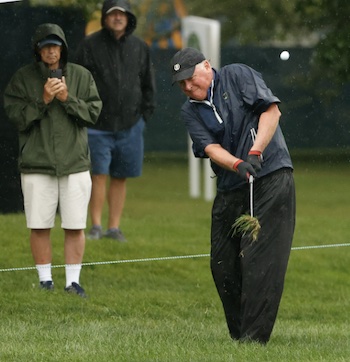
Gene Elliott chopping one out of the rough (USGA)
"I got to England at the British Am at Lytham and it was killing me," he said. "I gutted out 77-70 there and got home and went to my orthopedic guy. He took X-rays and said the rotator cuff is ok but I have impingement and gave me the [cortisone] shot."
Elliott's pain got even worse at the Senior Open. It's unlikely he will be able to cross the pond to defend his British Senior Am title or play in the British Senior Open. [6/27 update - his doctor said he could give it a go - Ed.] Golf is far from a contact sport, but injuries are part of the game -- especially at the senior level.
ROBERT FUNK AND "COUSIN FREDDIE"
I would challenge you to find a player that enjoys the ride as much as Robert Funk of Canyon Lake, California. Funk has a winning resume, having captured big senior tournaments like the California Senior Am after taking to the game as a relatively late bloomer.

The Funk cousins share a moment
The outgoing Funk doesn't squander a second of his fifteen minutes of fame.
At Salem Country Club in '17, he played a practice round with Bernhard Langer. "He showed me where to miss," said Funk, who was obviously a quick study.
This year, he got to spend more time with his cousin Fred Funk, who he said finally agrees that they are related after his sister retrieved a handwritten genealogy from his grandfather.
"He's a wonderful man," said Robert. "Very friendly."
BRYAN HOOPS: CHASING THE DREAM WHILE KEEPING IT ALL IN PERSPECTIVE
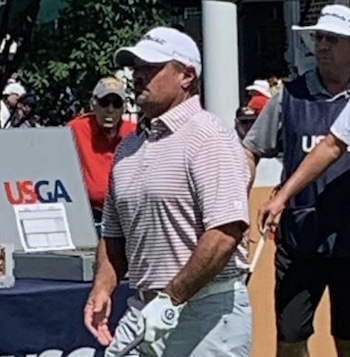
Bryan Hoops readies for action at Saucon Valley (B. Hoops)
The 5-time Arizona mid-am champion tied for 51st despite very respectable rounds of 75-75-71-71. To grab one of the five (you read right, just five) available spots would have required him to post 8-under, and climb past a number of names any golf fan would recognize. The next 30 players -- get this -- only earn the opportunity to avoid "pre-qualifying" for the Monday qualifiers held the week of each event. This year, reinstated amateur Michael Muehr decided to turn pro again after finishing T10 as the only other amateur who advanced to final qualifying.
Muehr has made it through more than one of those Monday grinds, and took home $3,960 at the Chubb Classic in February. But hey, he finished a shot ahead of Padraig Harrington and Billy Mayfair. Ken Tanigawa was winning just about everything in Arizona until 2017, when he gained full status on the Champions Tour. He's a multiple winner now, and in this year's Senior Open he set the record for the most birdies in a row with six.
Hoops (pronounced "hops") has enjoyed watching his close friend Tanigawa do exactly what he hopes to. After missing the cut at Saucon Valley this year, he stayed around for the weekend to support his friend, who ended up finishing T18 at 2-over.
"It's not life or death for me," said Hoops. "I have a great life here [in Arizona], my family and business are here so it's not the end of the world. If I make it through one of these years, I'll look at it as a 25-week golf vacation. It's a no-lose situation."
Results: U.S. Senior Open
| Place | Player | Location | Pts | Scores |
|---|---|---|---|---|
| MC | Spartanburg, SC | 0 | 73-75=148 | |
| MC | Montgomery, TX | 0 | 74-76=150 | |
| MC | Dalton, GA | 0 | 79-72=151 | |
| MC | Atlanta, GA | 0 | 77-74=151 | |
| MC | Atlanta, GA | 0 | 82-70=152 |
About the U.S. Senior Open
The U.S. Senior Open is one of 15 national championships conducted by the USGA. Open to amateurs and professionals who have reached their 50th birthday as of the first day of the championship.The Senior Open was first played in 1980 with a purse of, ...
Most Popular Articles
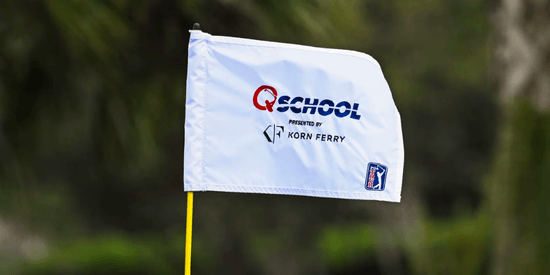
2025 PGA TOUR Q-School Guide: Sites, Scores, and Who Advanced
Dec 5, 2025Second Stage is complete and Final Stage awaits at Sawgrass — follow every Q-School leaderboard and the players still chasing
2025 LPGA TOUR Q-Series: Final Qualifying Stage FINAL SCORING
Dec 8, 2025Helen Briem earns medalist honors, 31 players headed to the LPGA next year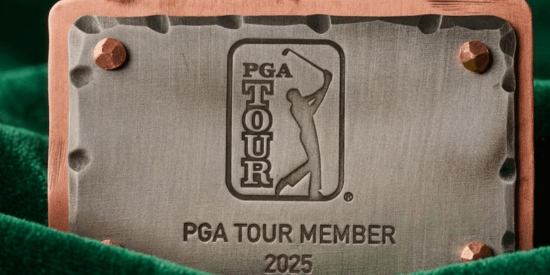
2025 PGA TOUR Q-School Final Stage: Ewart Leads Five New TOUR Card Winners
Dec 14, 2025A.J. Ewart topped Final Stage at TPC Sawgrass, leading five players who secured PGA TOUR membership for 2026.
Australian Open at Royal Melbourne: Preview, amateur bios, and how to watch
Nov 30, 2025Rory McIlroy headlines one of the championship's top fields in years - at least four amateurs will have their chance at gloryInside Gil Hanse’s Restoration of Baltusrol’s Upper Course: A Return to Tillinghast’s
Dec 11, 2025Renowned architect Gil Hanse reveals how he brought Baltusrol’s Upper Course back to life by honoring A.W. Tillinghast’s original